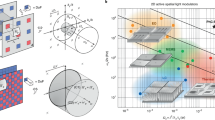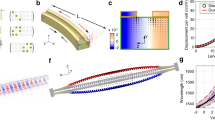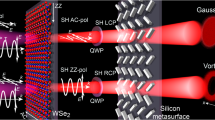Abstract
Efficient phase manipulation of light is the cornerstone of many advanced photonic applications1,2,3,4. However, the pursuit of compact, broadband and deep phase control of light has been hindered by the finite nonlinearity of the optical materials available for integrated photonics5,6. Here, we propose a dynamically driven photonic structure for deep phase manipulation and coherent spectrotemporal control of light based on distributed nanomechanics. We experimentally demonstrate the quasi-phase-matched interaction between stationary mechanical vibration and itinerant optical fields, which is used to generate an on-chip modulated frequency comb over 1.15 THz (160 lines), corresponding to a phase modulation depth of over 21.6π. In addition, an optical time-lens effect induced by mechanical vibration is realized, leading to optical pulse compression of over 70-fold to obtain a minimum pulse duration of 1.02 ps. The high efficiency and versatility make such mechanically driven dynamic photonic structures ideal for realizing complex optical control schemes, such as lossless non-reciprocity7, frequency division optical communication1 and optical frequency comb division8.
This is a preview of subscription content, access via your institution
Access options
Access Nature and 54 other Nature Portfolio journals
Get Nature+, our best-value online-access subscription
$29.99 / 30 days
cancel any time
Subscribe to this journal
Receive 12 print issues and online access
$209.00 per year
only $17.42 per issue
Buy this article
- Purchase on Springer Link
- Instant access to full article PDF
Prices may be subject to local taxes which are calculated during checkout




Similar content being viewed by others
Data availability
The data that support the plots within this paper and other findings of this study are available from the corresponding author upon reasonable request.
References
Ho, K.-P. Phase-Modulated Optical Communication Systems (Springer Science & Business Media, Berlin, 2005).
Agrawal, G. P. Fiber-optic Communication Systems Vol. 222 (John Wiley & Sons, New York, NY, 2012).
Lu, L., Joannopoulos, J. D. & Soljačić, M. Topological photonics. Nat. Photon. 8, 821–829 (2014).
Sounas, D. L. & Alù, A. Non-reciprocal photonics based on time modulation. Nat. Photon. 11, 774–783 (2017).
Leuthold, J., Koos, C. & Freude, W. Nonlinear silicon photonics. Nat. Photon. 4, 535–544 (2010).
Reed, G. T., Mashanovich, G., Gardes, F. & Thomson, D. Silicon optical modulators. Nat. Photon. 4, 518–526 (2010).
Fang, K., Yu, Z. & Fan, S. Realizing effective magnetic field for photons by controlling the phase of dynamic modulation. Nat. Photon. 6, 782–787 (2012).
Li, J., Yi, X., Lee, H., Diddams, S. A. & Vahala, K. J. Electro-optical frequency division and stable microwave synthesis. Science 345, 309–313 (2014).
Kolner, B. H. & Nazarathy, M. Temporal imaging with a time lens. Opt. Lett. 14, 630–632 (1989).
Karpiński, M., Jachura, M., Wright, L. J. & Smith, B. J. Bandwidth manipulation of quantum light by an electro-optic time lens. Nat. Photon. 11, 53–57 (2017).
Fang, K., Yu, Z. & Fan, S. Photonic Aharonov–Bohm effect based on dynamic modulation. Phys. Rev. Lett. 108, 153901 (2012).
Tzuang, L. D., Fang, K., Nussenzveig, P., Fan, S. & Lipson, M. Non-reciprocal phase shift induced by an effective magnetic flux for light. Nat. Photon. 8, 701–705 (2014).
Yu, Z. & Fan, S. Complete optical isolation created by indirect interband photonic transitions. Nat. Photon. 3, 91–94 (2009).
Feng, L. et al. Nonreciprocal light propagation in a silicon photonic circuit. Science 333, 729–733 (2011).
Sounas, D. L., Caloz, C. & Alu, A. Giant non-reciprocity at the subwavelength scale using angular momentum-biased metamaterials. Nat. Commun. 4, 2407 (2013).
Vahala, K. J. Optical microcavities. Nature 424, 839–846 (2003).
Kippenberg, T. J., Holzwarth, R. & Diddams, S. Microresonator-based optical frequency combs. Science 332, 555–559 (2011).
Wooten, E. L. et al. A review of lithium niobate modulators for fiber-optic communications systems. IEEE J. Sel. Topics Quantum Electron. 6, 69–82 (2000).
Bennett, C. V., Scott, R. P. & Kolner, B. H. Temporal magnification and reversal of 100 Gb/s optical data with an up-conversion time microscope. Appl. Phys. Lett. 65, 2513–2515 (1994).
Bennett, C. V. & Kolner, B. H. Principles of parametric temporal imaging. Part I. System configuration. IEEE J. Quant. Electron 36, 430–437 (2000).
Salem, R. et al. Optical time lens based on four-wave mixing on a silicon chip. Opt. Lett. 33, 1047–1049 (2008).
Aspelmeyer, M., Kippenberg, T. J. & Marquardt, F. Cavity optomechanics. Rev. Mod. Phys. 86, 1391 (2014).
Fan, L. et al. Integrated optomechanical single-photon frequency shifter. Nat. Photon. 10, 766–770 (2016).
Weis, S. et al. Optomechanically induced transparency. Science 330, 1520–1523 (2010).
Safavi-Naeini, A. H. et al. Electromagnetically induced transparency and slow light with optomechanics. Nature 472, 69–73 (2011).
Kittlaus, E. A., Shin, H. & Rakich, P. T. Large Brillouin amplification in silicon. Nat. Photon. 10, 463–467 (2016).
Boyd, R. W. Nonlinear Optics (Academic Press, Cambridge, MA, 2003).
Li, M. et al. Harnessing optical forces in integrated photonic circuits. Nature 456, 480–484 (2008).
Herr, T. et al. Temporal solitons in optical microresonators. Nat. Photon. 8, 145–152 (2014).
Ishizawa, A. et al. Phase-noise characteristics of a 25-GHz-spaced optical frequency comb based on a phase- and intensity-modulated laser. Opt. Express 21, 29186–29194 (2013).
Xiong, C. et al. Aluminum nitride as a new material for chip-scale optomechanics and nonlinear optics. New J. Phys. 14, 095014 (2012).
Wu, R., Supradeepa, V., Long, C. M., Leaird, D. E. & Weiner, A. M. Generation of very flat optical frequency combs from continuous-wave lasers using cascaded intensity and phase modulators driven by tailored radio frequency waveforms. Opt. Lett. 35, 3234–3236 (2010).
DeLong, K., Trebino, R., Hunter, J. & White, W. Frequency-resolved optical gating with the use of second-harmonic generation. J. Opt. Soc. Am. B 11, 2206–2215 (1994).
Bryan, D., Gerson, R. & Tomaschke, H. Increased optical damage resistance in lithium niobate. Appl. Phys. Lett. 44, 847–849 (1984).
Jung, H., Stoll, R., Guo, X., Fischer, D. & Tang, H. X. Green, red, and IR frequency comb line generation from single IR pump in AlN microring resonator. Optica 1, 396–399 (2014).
Fang, K. & Fan, S. Controlling the flow of light using the inhomogeneous effective gauge field that emerges from dynamic modulation. Phys. Rev. Lett. 111, 203901 (2013).
Acknowledgements
We acknowledge funding support from an LPS/ARO grant (W911NF-14-1-0563), an AFOSR MURI grant (FA9550-15-1-0029), a NSF EFRI grant (EFMA-1640959) and the DARPA SCOUT programme, as well as the Packard Foundation. The facilities used were supported by Yale Institute for Nanoscience and Quantum Engineering and NSF MRSEC DMR 1119826. We thank L. Jiang for discussions, and M. Power, M. Rooks and L. Frunzio for assistance with device fabrication.
Author information
Authors and Affiliations
Contributions
H.X.T., L.F. and C.-L.Z. conceived the experiment. L.F. fabricated the device. N.Z. fabricated the 3D cavity. L.F. and N.Z. performed the experiment. L.F. and C.-L.Z. analysed the data. All authors contributed to writing the manuscript. H.X.T. supervised the work.
Corresponding author
Ethics declarations
Competing interests
The authors declare no competing interests.
Additional information
Publisher’s note: Springer Nature remains neutral with regard to jurisdictional claims in published maps and institutional affiliations.
Supplementary information
Supplementary Information
Supplementary theory and discussion, Supplementary Figures 1–4 and Supplementary References 1–4.
Rights and permissions
About this article
Cite this article
Fan, L., Zou, CL., Zhu, N. et al. Spectrotemporal shaping of itinerant photons via distributed nanomechanics. Nat. Photonics 13, 323–327 (2019). https://doi.org/10.1038/s41566-019-0375-9
Received:
Accepted:
Published:
Issue Date:
DOI: https://doi.org/10.1038/s41566-019-0375-9
This article is cited by
-
On-chip parallel processing of quantum frequency comb
npj Quantum Information (2023)
-
In situ control of effective Kerr nonlinearity with Pockels integrated photonics
Nature Physics (2022)
-
Spectral control of nonclassical light pulses using an integrated thin-film lithium niobate modulator
Light: Science & Applications (2022)
-
Hybrid integrated photonics using bulk acoustic resonators
Nature Communications (2020)
-
Efficient bidirectional piezo-optomechanical transduction between microwave and optical frequency
Nature Communications (2020)



